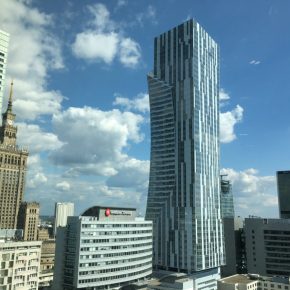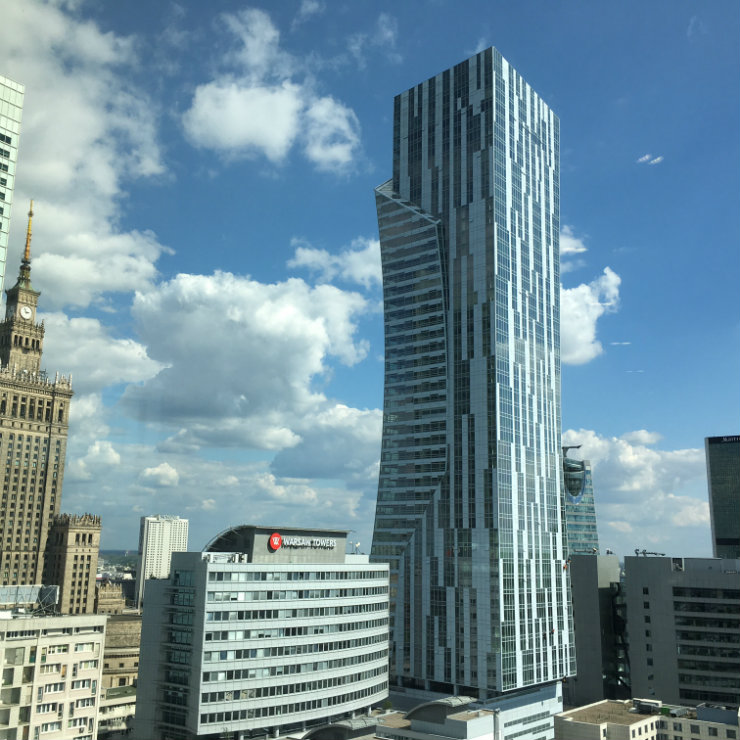Tydzień w gospodarce
Category: Raporty

Warsaw, Poland (Maria Bnińska, Public domain)
All four markets witnessed a surge of demand last year which has further encouraged the construction of new offices for delivery in 2017 and 2018. Across all office markets mentioned, the delivery of new large-scale developments (20,000 sqm+) is expected, particularly in Warsaw.
The Polish property market is generating high yields, according to the online broker, tranio.com, with about EUR4.5bn invested commercial property in 2016, the highest volume since 2006. “There are two main reasons for this performance,” Tranio.com real estate expert, Yulia Kozhevnikova, reportedly said.
“Following the Brexit referendum, many buyers of investment properties have opted for Poland as an alternative, as it is the largest developing market in Central Europe, accounting for half of the investments in the region,” Kozhevnikova said.
Warsaw is the biggest business and finance hub of not only Poland, but also the whole of Central and Eastern Europe, but other cities in Poland also draw attention from foreign investors.
“Investors consider Poland a steady market. Commercial real estate supply in Warsaw and provincial towns is still under development, which is why there is still more potential for market growth,” Yulia Kozhevnikova said.
Warsaw, with over 5 million sqm of modern office stock, is the long-term largest office market in Central Europe. Continued strong demand and large public investment, especially into public transportation infrastructure (extension of the second metro line), has backed a growing Warsaw office market and created a broader offer of locations suitable for office developments.
The most sought-after locations are the City Centre, Motoków (Upper South) and South-West, in particular locations such as Daszyńskiego Roundabout, Dworzec Gdański and Jerozolimskie Avenue.
Demand for modern offices in Warsaw comes predominantly from professional services, manufacturers, IT/Telco companies and banks/financial firms, with a combined share on demand of 74 percent. New office supply in 2016 was 407,000 sqm, with the following largest developments: Warsaw Spire (59,100 sqm), Q22 (46,400 sqm) Gdański Business Center (29,300 sqm) and West Station I (28,700 sqm). Currently, there is 675,000 sqm of modern office space under construction, out of which, 46 percent is concentrated in central locations. The current prime rent in the most sought-after locations in the City Centre area reaches EUR23.50 sqm/month.
During the last three years, companies have leased nearly 4 million sqm of modern office space in Poland. Taking the dynamic development of firms into consideration, 2017-2019 can generate office demand of up to 5 million sqm, real estate advisory firm JLL estimates.
Over 3.9 million sqm of modern office space was delivered throughout Poland over the last seven years. Furthermore, a majority of this space has been effectively absorbed by the market.
From 2017 to 2019, it is expected that another approximately 2.5 million sqm will be delivered to market with nearly 40 per cent (950,000 sqm) being located in Warsaw alone. Developers also aim to complete a further 400,000 sqm of space in Kraków, which is the biggest destination for business services centres in this part of the world.
“In recent years, Poland has become an extremely attractive business destination for numerous global brands that both launch and develop their units in the country, providing services for increasingly advanced processes,” commented Tomasz Trzósło, Managing Director, JLL Poland. “The most important examples of new investments in recent years, or even months, include State Street and Swarovski in Gdańsk; Credit Suisse, Dentons, DLA Piper, Goldman Sachs, William Demant in Warsaw; Red Embedded and UBS in Wrocław; TRW and Whirpool in Łódź; Guidewire, Uber and Zurich Insurance Group in Kraków as well as Rockwool in Poznań. Although these companies already occupy substantial office space, they continue to develop and as a result generate demand for additional square meters.”
In Warsaw, the share of expansion agreements in overall demand was 10 per cent (75,900 sqm) in 2016 while on regional markets it was 13 per cent (20 per cent in Kraków). What is also significant is the percentage of pre-let agreements in the demand for office space, especially outside Warsaw – pre-let deals accounted for 38 per cent of overall demand on regional markets. In total, the volume of pre-let agreements in Poland exceeded 347,000 sqm in 2016.
“The sound performance of the office market in 2014-2016 was underpinned by strong demand and net absorption,” said Mateusz Polkowski, Head of Research and Consulting, JLL Poland. “During the last three years, companies leased in total nearly 4 million sqm of space on the major office markets in Poland. Considering the strong development among firms, including those from the business services sector, we can expect the demand to hit a total of 5 million sqm in the next three years (2017-2019.”
Consolidations and growth of companies already operating on the market generate the need for new offices. As a result, demand for large space is often focused around objects that are either under construction or even scheduled to be developed. Therefore, office developers continue to launch new investments, even if this is on a speculative basis, expecting interest among major market players. In parallel to the consolidation trend visible among large entities, some corporations have decided to launch their units in smaller cities.
“Another change happening on Poland’s office market is the revision of lease strategies among property owners of older buildings,” adds Mateusz Polkowski. “Typical locations for international giants primarily constitute the most modern objects.
Tranio expects that there will be a rise in the gap between prime and lower-budget property rental rates in 2017 and a shift in investor interest to provincial towns, including Gdańsk, Łódź and Poznań.
Housing
Prices for real estate in Poland are rising, whereas rental rates in 2015-2016 were stable (in the retail real estate sector) or in decline (in the office and industrial sectors).
Housing prices grew from 2004, the year of Poland’s EU accession until 2010, after which prices fluctuated. From 2014 to 2015, the price of a square meter fell by 1.4 per cent; however, in 2016 there was visible growth to 4.2 per cent. In the past 10 years in total, housing prices have increased by 56.3 per cent.
The average cost of a square meter in Poland (EUR934.5) is significantly lower than in other European countries. For comparison, housing in Spain costs on average EUR1,600 EUR/sqm, and in Germany EUR 2,400/sqm.
Industrial market
In Q1’2017, gross demand on the industrial space market in Poland was a record-breaking 855,000 sqm. In addition, the market gained 538,000 sqm of newly developed space. This constitutes the strongest opening to a year in the market’s history, according to a recent summary on the conditions on Poland’s industrial market at the end of Q1 2017 by JLL.
Tomasz Mika, Head of Industrial, JLL Poland, said: “The industrial sector in Poland continues to excel. We had the best first quarter in the market’s history, which augurs well for the rest of 2017. Companies signed lease agreements for 855,000 sqm with new contracts accounting for 647,800 sqm – a 75 percent share of gross take-up. In Q1 2017, the most significant activity among tenants was recorded in the region of Upper Silesia, followed by Warsaw Suburbs and Wrocław.”
Almost 70 per cent of demand was attributable to two developers – Panattoni and Prologis. As per usual, the three sectors which had the greatest share in Q1 take-up were retailers (including e-commerce), which signed lease agreements for a total of 250,600 sqm (gross demand), logistic operators (277,300 sqm) and firms from the light manufacturing industry (174,400 sqm). In Q1 2017, the biggest lease agreement – for 135,000 sqm – was signed by Amazon in a BTS investment developed by Panattoni in Sosnowiec.
Over the last couple of years, Budapest has ranked in the second position among Central European capitals in terms of modern office stock, which currently totals 3.36 million sqm. Demand for modern administrative space in Budapest was enormous last year and reached 467,100 sqm. The office market is very liquid and new projects launched to the market are quickly gaining tenants´ attention and are often completed with high proportions of pre-leases. In 2016, the Budapest office market saw the delivery of six schemes with a total area of 96,300 sqm. For 2017, we expect 90,500 sqm of modern offices to be delivered and a further 240,000 sqm to be delivered in 2018. The largest submarkets of the office stock are Váci Corridor (with 27 per cent of the total stock), Pest Central South (14 per cent) and Buda South (12 per cent). The prime office rent in premium office buildings is up to EUR22 sqm/month.
With its modern office stock of 3.21 million sqm, Prague ranks closely behind Budapest as the third largest office market in Central Europe. Last year, Prague’s office market witnessed its lowest ever office supply of 33,400 sqm. This will change over the next two years as there are currently 330,000 sqm of modern offices under construction in Prague, out of which, 171,000 sqm is due to be delivered in 2017. A booming economy has backed strong demand for new office space (gross take-up for 2016 reached 414,300 sqm) and forms grounds for an optimistic forecast for 2017 as well. The most sought-after locations are the easily accessible and established locations of Prague 4 (27 per cent of the total stock), Prague 5 (16.2 per cent) and Prague 1 (15.8 per cent) among which the most office construction is concentrated. The fastest growing submarket is Prague 8 with current supply under construction of 74,400 sqm. The prime office rent for A-grade office buildings in Prague 1 is quoted at EUR20 sqm/month.
Bratislava’s office market, with a total stock of 1.62 million sqm is registering a significant growth. Currently, there is 230,000 sqm of modern office space under construction, out of which half is already pre-leased. Most of the development schemes are being built in the City Centre (Bratislava I). Last year, the Slovak capital witnessed the highest office demand since 2008, totaling 233,500 sqm. Demand for office space is driven by professional services, FMCG companies and IT firms. Among the Central European capitals, Bratislava boasts the lowest average office vacancy rate at 6.61 per cent and the lowest prime office rents that vary between EUR13.5-15 sqm/month.
“The Central European capital city office markets of Bratislava, Budapest, Prague and Warsaw have each performed well during 2016, particularly in terms of demand. Each of the markets have something different to offer companies looking for new or more office space and can therefore cater to a wide variety of demand. Whether it be the location, quality, availability or cost of office space, these markets can satisfy even the most selective of companies. The healthy levels of new office supply in the pipeline for 2017 and 2018 will ensure that there is a good variety of choice as well. In addition, the fact that these markets offer highly skilled and educated labor and very competitive costs compared to Western Europe continues to make the Central European region attractive,” commented Kevin Turpin, Head of Research of JLL for CEE.

